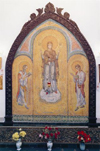KALININGRAD DOMCHOIR |
||
KALININGRADKaliningrad is a small enclave surrounded by Lithuania , Poland and the Baltic Sea. In area it is about 1/3 of the size of the Netherlands. Up until the 13th century when the ‘Teutonic’ or Germanic Order occupied the region, it was home to the Baltic people of ‘Prussia’. Over the centuries, these people have disappeared as they have become part of the German population who lived here. In 1255 the City of Königsberg (Koningsbergen) was established on the River Pregel. At one time the city was bigger and more important than Berlin. Königsberg lent its importance among other things to its housing the court of the Kings of Prussia and the famous Albertina University. Eastern Prussia was a prosperous agricultural region. In the period after August 1944 the population endured hard times, first with the bombardment of its towns and cities and then above all when Eastern Prussia was the first region in Germany occupied by the Russian army. During the freezing winter of 1944-45 many of the population fled. Eastern Prussia was divided between Poland and the northern part which became part of the Soviet Union. The Russian part and the capital were given the name Kaliningrad. It became an isolated, military area which only became accessible to other Russians and to foreigners following the collapse of the Soviet Union. At the same time, the region found itself once more isolated as both Latvia and White Russia became independent states. The neighbouring countries Poland and Latvia joined the EU. These developments have only served to make it more difficult for the population of Kaliningrad. |
foto's |
|






